Hamlet Bareh | |
|---|---|
| Born | 3 May 1931 Jaiaw Lumsyntiew, Meghalaya, India |
| Died | 24 July 2012 |
| Resting place | Church of North India cemetery, Shillong, India 25°33′45″N91°52′13″E / 25.56250°N 91.87028°E |
| Occupation(s) | Historian Writer Filmmaker |
| Spouse | Merlicia Kharshiing |
| Children | Four children |
| Parent(s) | Mondon Bareh Besina Dkhar |
| Awards | Padma Shri Meghalaya Day Award |
Hamlet Bareh Ngapkynta (1931-2012) was an Indian writer, historian and film director from the Northeast Indian state of Meghalaya. [1] He is known as the first person from the Khasi tribe, an indigenous ethic group of the state, to secure a doctoral degree (PhD) [2] and as the maker of the first feature film in Khasi language, Ka Synjuk Ri ki Laiphew Syiem (The Alliance of Thirty Kings). [3] He was the chairman of the executive committee of the Rajiv Gandhi University, Arunachal Pradesh and a recipient of the 2004 Meghalaya Day Award. [1] The Government of India awarded him the fourth highest civilian honour of the Padma Shri in 2004, [4]
Hamlet Bareh was born in Jaiaw Lumsyntiew, a village in the Northeast Indian state of Meghalaya on 3 May 1931 to Besina Dkhar and Mondon Bareh, an educationist, as the youngest of their ten children. [5] He was brought up by his mother as his father died before he turned one and he did his schooling at Jaiaw Practising School, Khasi Jaintia National School and Shillong Boys' Government High School and did his graduate studies at St. Edmund's College, Shillong. [2] His master's studies were at Guwahati University from where he also secured his doctoral degree (PhD) in 1963 for his thesis, The origin and history of the Khasi people, becoming the first Khasi person to receive a doctoral degree. [1] The achievement is reported to have earned him a congratulatory letter from Indira Gandhi, the then Prime Minister of India. [5]
Bareh had started his career while doing his master's degree studies as a teacher at the local Government High School. Later, he would work as a publicity officer of Union Christian College, before joining his alma mater, St. Edmund's College, Shillong, to teach History and Khasi language. [6] After completing his doctoral studies, he resigned from College and took up the post of the Editor of the District Gazetteers of the present day Arunachal Pradesh, then known as North East Frontier Agency (NEFA). [5] He also worked as a visiting fellow of the Indian Institute of Advanced Study, Shimla during 1973–74. [5] When North Eastern Hill University was established in 1974, Bareh was appointed as the Reader, with the responsibility of its continuing education as well as the adult education programmes. He stayed at the university until his retirement in 1996, before which he served the institution as the founder Head and professor of its Centre for Creative Arts. [1]
Towards the later stages of his life, he was appointed as the Chairman of the executive committee of Rajiv Gandhi University, in Arunachal Pradesh. [7] He died at Shillong on 24 July 2012, at the age of 81. [2] His wife, Merlicia Kharshiing, preceded him in death and he was survived by their four children. [2] His body was laid to rest in the Church of North India Cemetery in Shillong. [1]
Bareh is reported to have been active in the educational, literary and cultural fronts of the state of Meghalaya. He served as the secretary of the North East India Christian Literature Board and was a member of the North East Council. [5] He was one of the founders of the Synod College, Shillong and was involved with spreading education in the remote areas of the state. He was a member of the Indian Council of Historical Research (1984–87), the Indian Institute of Public Administration, Delhi, Kamarupa Anusandhan Samiti (Assam Research Society), North Eastern Economic Association and the Sardar Patel Society, Delhi. He was associated with the Sahitya Akademi (1981–87) and served as a member of its expert committee. He was also a member of the advisory boards of the State Council of Educational Research and Training, Delhi and the State department of Art and Culture. [5]
Bareh was the president of the Khasi Cultural Society and Khasi Jaiñtia Welfare Association and when the Society produced a feature film, Ka Synjuk Ri Ki Laiphew Syiem (The Alliance of Thirty Kings), he was selected to direct the film. [2] A 35-minute-long short feature film, it was the first ever feature film made in Khasi language [3] and featured a couple of songs written by him. [5] During 1998–2000, he was involved in writing two of his books, under the Emeritus fellowship of the University Grants Commission; he had earlier received the National Fellowship of the UGC. [7]
Besides many articles, [8] Bareh published several books, [9] reported to be over 50, which included The Art History of Meghalaya, [10] William Carey in a new perspective, [11] A Short History of Khasi Literature, [12] The Language and Literature of Meghalaya, [13] The History and Culture of the Khasi People [14] and The Church of England. [2] He also wrote two books, Progress of Education in Meghalaya, [15] and The Distinguished Educationalists of Meghalaya Past and Present, [16] on the education in Meghalaya and an eight-volume encyclopedia, Encyclopaedia of North-east India. [17] Who's who of Men and Women of Achievement (fourth edition-1989) and Learned Asia (volume 1–1992) have listed his name. [1] The Government of Meghalaya honoured him with U Tirot Sing Award on Meghalaya Day on 21 January 2004. [18] Five days later, the Government of India included him in the Republic Day honours list for the civilian honour of the Padma Shri. [4]

Meghalaya is a state in northeast India. Meghalaya was formed on 21 January 1972 by carving out two districts from the state of Assam: (a) the United Khasi Hills and Jaintia Hills and (b) the Garo Hills. The population of Meghalaya as of 2014 is estimated to be 3,211,474. Meghalaya covers an area of approximately 22,430 square kilometres, with a length-to-breadth ratio of about 3:1.

Shillong is a hill station and the capital of Meghalaya, a state in northeastern India. It is the headquarters of the East Khasi Hills district. Shillong is the 330th most populous city in India with a population of 143,229 according to the 2011 census. It is said that the rolling hills around the town reminded the British of Scotland. Hence, they would also refer to it as the "Scotland of the East".
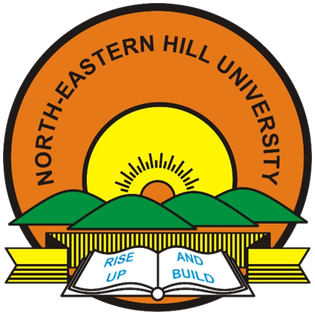
North-Eastern Hill University (NEHU) is a Central University established on 19 July 1973 by an Act of the Indian Parliament. The university is in the suburb of Shillong, the state capital of Meghalaya, India. The university has two campuses: Shillong and Tura both are in Meghalaya. The first pro-vice chancellor was Early Rising Singha

The Khasi people are an ethnic group of Meghalaya in north-eastern India with a significant population in the bordering state of Assam, and in certain parts of Bangladesh. Khasi people form the majority of the population of the eastern part of Meghalaya, that is Khasi Hills, constituting 78.3% of the region's population, and is the state's largest community, with around 48% of the population of Meghalaya. They are among the few Austroasiatic-speaking peoples in South Asia. The Khasi tribe holds the distinction of being one of the few remaining matriarchal tribes of the world. Under the Constitution of India, the Khasis have been granted the status of Scheduled Tribe.

The Jaintia Kingdom was a matrilineal kingdom in present-day Bangladesh's Sylhet Division, India's Meghalaya state and Nagaon, Morigoan district of Assam. It was partitioned into three in 630 AD by Raja Guhak for his three sons, into the Jaintia Kingdom, Gour Kingdom and Laur Kingdom. It was annexed by the British East India Company in 1835. All the Khasi (Pnar) Rajahs of the Jaintiapur Kingdom are from the Syiem Sutnga clan, a Pnar clan of the Khasi tribe which claims descent from Ka Li Dohkha, a divine nymph.
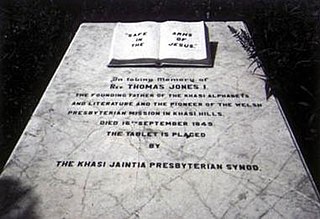
Thomas Jones was a Welsh Christian missionary, who worked among the Khasi people of Meghalaya and Assam in India and of Bangladesh. He recorded the Khasi language in Roman script, and the inscription on his gravestone calls him "The founding father of the Khasi alphabets and literature".
Tirot Sing, also known as U Tirot Sing Syiem born in the year 1802 and died in the year 1835, was one of the chiefs of the Khasi people in the early 19th century. He drew his lineage from the Syiemlieh clan. He was Syiem (chief) of Nongkhlaw, part of the Khasi Hills. His surname was Syiemlieh. He was a constitutional head sharing corporate authority with his Council, general representatives of the leading clans within his territory. Tirot Sing declared war and fought against British for attempts to take over control of the Khasi Hills.

The Khasi and Jaintia Hills are a mountainous region that was mainly part of Assam and Meghalaya. This area is now part of the present Indian constitutive state of Meghalaya, which includes the present districts of East Jaintia Hills district, headquarter Khliehriat, West Jaintia Hills district, headquarter Jowai, East Khasi Hills district, headquarter Shillong, and West Khasi Hills district, headquarter Nongstoin.
Dr. H. Gordon Roberts Hospital, Shillong, or KJP Hospital, is one of the oldest medical centres in Meghalaya. This Christian institution was founded by Dr. Hughes Gordon Roberts and is located in the city of Shillong in the north east of India.

Neil Nongkynrih was an Indian concert pianist and conductor. He founded the Shillong Chamber Choir (SCC), which won the reality show India's Got Talent in 2010. He was awarded Padma Shri, the fourth highest civilian award of India in 2015.
Dkhar, is a term used by the Khasis to refer to non-Khasi people in Meghalaya. It is non derogatory but some perceived it as derogatory. For Khasis any non-tribal is a dkhar and they address them by that term. In real, the term is mostly used against affluent Bengali Hindu settlers from West Bengal or the Bengali Hindu refugees from erstwhile East Pakistan It is sometimes abbreviated to ′Khar and may also denote a Khasi clan with the same name.
Daying Ering (1929–1970) was an Indian politician from Arunachal Pradesh. He was the chairman of the Ering Commission which heavily influenced the country's panchayati raj system.
Bertha Gyndykes Dkhar is a visually impaired Indian educationist, best known as the inventor of the braille code in Khasi. In 2010, the Government of India awarded her with the Padma Shri, India's fourth highest civilian award.
Patricia Mukhim is an Indian social activist, writer, journalist and the editor of Shillong Times, known for her social activism. A recipient of honours such as Chameli Devi Jain award, ONE India award, Federation of Indian Chambers of Commerce and Industry FLO award, Upendra Nath Brahma Soldier of Humanity award, Siva Prasad Barooah National award and North East Excellence award, she was honored by the Government of India, in 2000, with the fourth highest Indian civilian award of Padma Shri.
Silverine Swer (1910–2014), popularly known as Kong Sil, was an Indian social and environmental activist, educationist and civil servant. She was the first person of tribal origin to hold senior posts with the Government of Meghalaya, and was a recipient of the Silver Elephant Medal of the Bharat Scouts and Guides Award and Kaisar-i-Hind Medal. The Government of India awarded her the fourth highest civilian award of Padma Shri in 1990, making her the first recipient of the award from the state of Meghalaya.
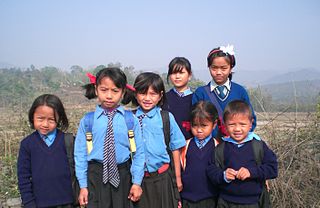
The hill tribes of Northeast India are hill people, mostly classified as Scheduled Tribes (STs), who live in the Northeast India region. This region has the largest proportion of scheduled tribes in the country.
Khasi Cinema is the term used to refer to the Khasi language film industry based in Shillong in Meghalaya, India. In 1981, Hamlet Bareh Ngapkynta's 1981 film Ka Synjuk Ri ki Laiphew Syiem became the first ever film in Khasi. Years later, Ardhendu Bhattacharya's 1984 film Manik Raitong became the first ever color film in the Khasi language. After the 2000s when militancy in the state came down drastically, a market for entertainment and movies opened up. Many short films and telefilms began being produced in the Khasi language. The production of feature films in Khasi got a major fillip after the entry of national award winning filmmakers like Pradip Kurbah into the scene.
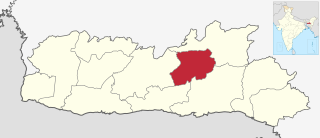
Eastern West Khasi Hills is a district in the Indian state of Meghalaya, located approximately 25 kilometres (16 mi) west of the state capital of Shillong. It was created in 2021, after bifurcation of existing West Khasi Hills district. The territories which make up the district recorded a total population of 131,451 in the 2011 census. The district headquarters is the town of Mairang.
Sayeedullah Nongrum is an Indian politician and philanthropist. He was a three-time MLA for Rajabala constituency at the Meghalaya Legislative Assembly.
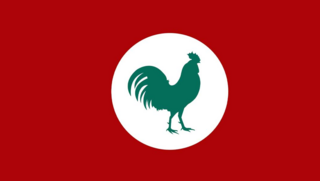
The Seng Khasi movement, also known as the Khasi Students' Union, is a social and political movement that originated in the Khasi Hills region of the Indian state of Meghalaya. The movement was founded in the 1899 by a group of Khasi who were concerned about the loss of traditional Khasi culture and values due to the influence of British colonial rule and Christian missionaries.